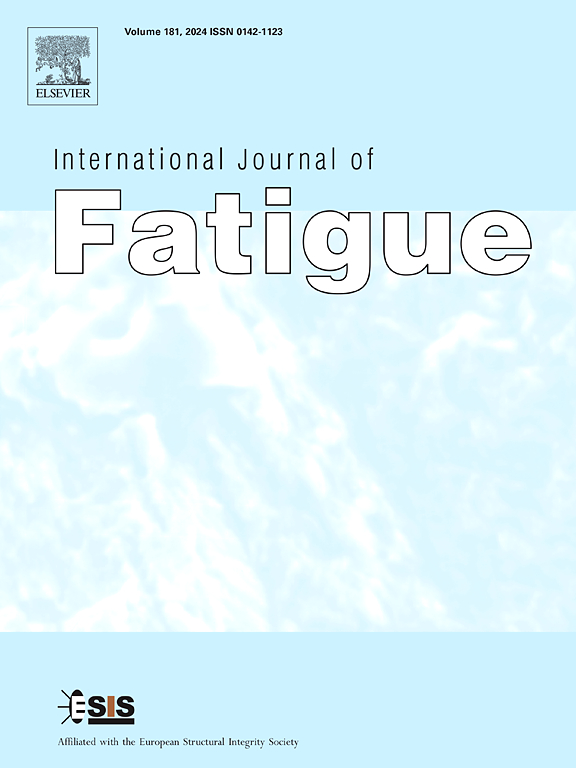Effect of different precipitated phase structures on low-cycle fatigue properties of Mg-Gd-Y-Zn-Zr alloy
IF 5.7
2区 材料科学
Q1 ENGINEERING, MECHANICAL
引用次数: 0
Abstract
This study conducts low-cycle fatigue tests on an extruded magnesium alloy cabin. The relationship between the microstructure and macroscopic cyclic-deformation behavior was established by regulating the microstructure of the different precipitated phases. The results show that only the β’ phase is precipitated in the 200AT sample, and lamellar Long-Period Stacking Ordered (LPSO) phase and β’ phase overlapping structures are precipitated in the 250AT sample. Different microstructural states lead to the intersection of the fatigue-life curves of the two samples. Under a low strain amplitude, the 200AT sample is more likely to produce short-range reversible basal slip, which easily releases stress and has a high fatigue life. The 250AT sample has a low fatigue life because the stress concentration in the grain caused by the irreversible < c + a > slip of the medium growth process leads to higher intragranular strength, and the crack initiates along the grain boundary with weaker strength. At high strain amplitudes, cracks in the 200AT sample mainly propagate along the basal and prismatic planes with faster crack-propagation speeds and lower fatigue resistance. In contrast, cracks in the 250AT sample mainly propagate along the pyramidal < a > and pyramidal < c + a > directions with slower crack-propagation speeds and higher fatigue resistance.
不同析出相组织对Mg-Gd-Y-Zn-Zr合金低周疲劳性能的影响
对挤压镁合金客舱进行了低周疲劳试验。通过调节不同析出相的组织,建立了微观组织与宏观循环变形行为之间的关系。结果表明,在200AT样品中只析出β′相,而在250AT样品中析出了长周期有序堆积(LPSO)层状相和β′相重叠结构。不同的组织状态导致两种试样的疲劳寿命曲线相交。在低应变幅下,200AT试样更容易产生短距离可逆基滑移,容易释放应力,具有较高的疲劳寿命。250AT试样的疲劳寿命较低,主要是由于不可逆的高温作用引起的应力集中在晶粒内;c + a >;介质生长过程的滑移导致了较高的晶内强度,裂纹沿晶界萌生,强度较弱。在高应变幅下,200AT试样裂纹主要沿基面和棱柱面扩展,裂纹扩展速度较快,疲劳抗力较低。250AT试样的裂纹主要沿锥体<扩展;一个比;金字塔形的<;c + a >;裂纹扩展速度较慢,抗疲劳性能较高的方向。
本文章由计算机程序翻译,如有差异,请以英文原文为准。
求助全文
约1分钟内获得全文
求助全文
来源期刊

International Journal of Fatigue
工程技术-材料科学:综合
CiteScore
10.70
自引率
21.70%
发文量
619
审稿时长
58 days
期刊介绍:
Typical subjects discussed in International Journal of Fatigue address:
Novel fatigue testing and characterization methods (new kinds of fatigue tests, critical evaluation of existing methods, in situ measurement of fatigue degradation, non-contact field measurements)
Multiaxial fatigue and complex loading effects of materials and structures, exploring state-of-the-art concepts in degradation under cyclic loading
Fatigue in the very high cycle regime, including failure mode transitions from surface to subsurface, effects of surface treatment, processing, and loading conditions
Modeling (including degradation processes and related driving forces, multiscale/multi-resolution methods, computational hierarchical and concurrent methods for coupled component and material responses, novel methods for notch root analysis, fracture mechanics, damage mechanics, crack growth kinetics, life prediction and durability, and prediction of stochastic fatigue behavior reflecting microstructure and service conditions)
Models for early stages of fatigue crack formation and growth that explicitly consider microstructure and relevant materials science aspects
Understanding the influence or manufacturing and processing route on fatigue degradation, and embedding this understanding in more predictive schemes for mitigation and design against fatigue
Prognosis and damage state awareness (including sensors, monitoring, methodology, interactive control, accelerated methods, data interpretation)
Applications of technologies associated with fatigue and their implications for structural integrity and reliability. This includes issues related to design, operation and maintenance, i.e., life cycle engineering
Smart materials and structures that can sense and mitigate fatigue degradation
Fatigue of devices and structures at small scales, including effects of process route and surfaces/interfaces.
 求助内容:
求助内容: 应助结果提醒方式:
应助结果提醒方式:


